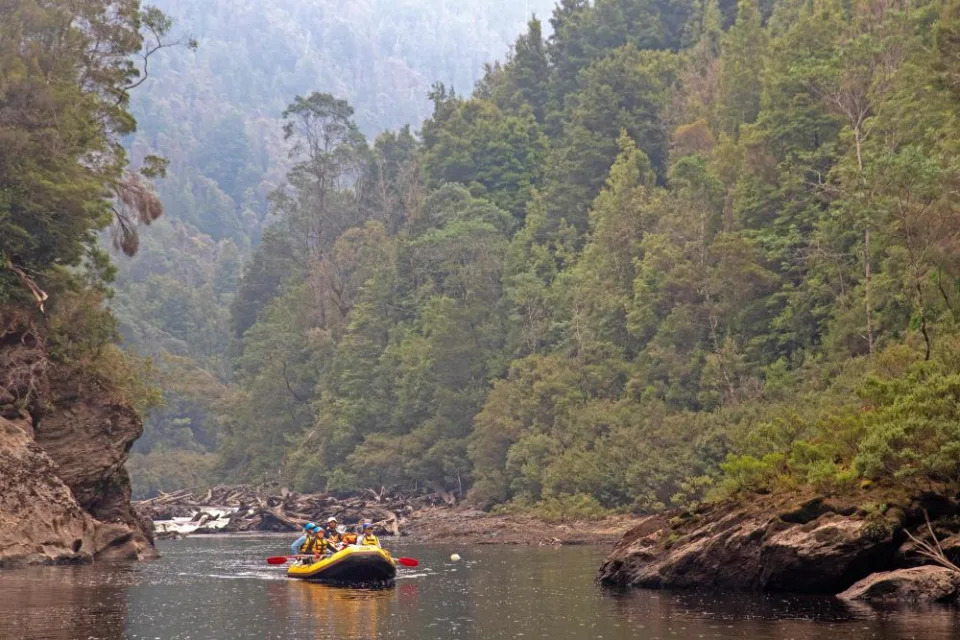Four decades on, has the Franklin River and those who fought to save it been forgotten?
Peter Hannam
Sun, 2 April 2023
Jeni Wallwork’s recent journey down Tasmania’s Franklin River was wild and treacherous but the 72-year-old trusted a splash of karma would get her through.
“My raft with four others capsized on the first day and we were stuck under water in the washing machine of a rapid for what seemed like a long time,” she says. “I thought about my mortality in those seconds … but should’ve realised that the river wouldn’t take a protester!”
Her “Amazon woman friend”, Kathy Fox, helped haul Wallwork back into her raft but the dumping meant “freezing almost to hypothermia for hours until we reached camp”. The eight-day trip was “the most terrifying, fear-inducing, challenging, exciting, beautiful, amazing thing I think I’ve ever done”.

Rafting on the Franklin River. Photograph: Andrew Bain/Alamy
Each year, fewer than 500 people take the chance to tackle one of the world’s most famous rafting rivers. For Wallwork, the odyssey had added poignancy, coming 40 years after she and her late husband, John Bright, joined thousands protesting in Tasmania and on mainland Australia to prevent the Franklin being dammed.
“I put a small amount of his ashes in the river the third day in. Of course he beat me to the end of the trip!” she says, adding later, “It’s sad that it was too late for John” who died four years ago.
Related: ‘The Franklin would be dammed today’: Australia’s shrinking environmental protections
All up, 1,272 protesters would be arrested over the four months to March 1983. Most were charged for trying to block bulldozers and construction workers near the proposed dam site on the Gordon River.
Both major parties in Tasmania – the Liberals then in government and Labor – backed at least two dams that would have flooded a large region of the Franklin catchment and tributaries. The Hawke government, which won office 40 years ago this month, launched action in the high court, securing a narrow 4-3 vote in its favour the following July that finally ended the project.
“It was wonderful to be thanked in person by our young rafting guides and young fellow rafters for protesting and thus saving the river for us all,” says Wallwork, an artist and designer, recalling marches in Hobart she and John attended.
The Gordon-below-Franklin dam would have delivered 172 megawatts of electricity, an amount that today seems almost trivial – it’s roughly what Australians now add every three weeks in rooftop solar capacity alone – and was not even needed at the time, says Andrew Blakers, an Australian National University professor.
Blakers, a doctoral student at the time of the blockade, made submissions to a Senate inquiry into the dam plans in lieu of protesting himself.
“My brother, father, mother and sister were in jail at the time I was writing,” he says, adding that his estimates of Tasmania’s power needs were far lower than projected by the Hydro-Electric Commission “and still higher than actually happened”.
Logbooks at the Newlands caves near the last major rapids on the Franklin and at the Sir John Falls hut on the Gordon River at the end of the 125km journey detail memories of blockaders grateful to have made it through the unspoilt wilderness, with its soaring ravines and lush rainforest.
“My first association with the Franklin was the Sydney protest march in early 1980s,” Felicity Hall wrote a year ago, illustrating her entry with a leatherwood in flower. “Fantastic to finally experience the Franklin in its wild state.”
“Group of 27 people joined to celebrate 30 years to the day that the Franklin River Blockade started. We are the UPRIVER MOB,” Alice Hungerford wrote in an entry dated 15-19 December 2012. “We have reclaimed this hut – the old hydroelectric Commission/Police camp – for the people.
The Franklin itself was just symptomatic of all of the beautiful places that had been destroyed in the past
David Clarke, river guide
“We have revisited the old camps, the old tracks, monitored the regrowth on the destruction site, and sang songs, eaten food and generally celebrated our beautiful world heritage,” Hungerford wrote.
Carmel, another member of the group, wrote it was “remarkable” to be part of a “family re-united directly opposite Warner’s Landing where we were arrested blockading the bulldozer. Uplifting to see how the rainforest has regrown.”
“Twenty-six years ago, the magistrate ordered me not to lurk, loiter, hide or secrete myself in the south-west of Tasmania,” wrote John McLaine in an entry after “an excellent trip” down the river in 2009. “I’m still defying those Blockade bail conditions!”
That those records and the hut itself have been preserved owes much to decades of devotion by David and Judith Clarke, members of the Franklin River Wildcare branch, who have coaxed dozens of volunteers to help save the history that governments haven’t been eager to celebrate.
David Clarke, a river guide who was honoured 30 years on for saving a rafter’s life, says many paddlers take the Franklin’s rescue for granted.
“It was an awakening,” he said last month during his latest work trip to restore the Sir John Falls hut. “The Franklin itself was just symptomatic of all of the beautiful places that had been destroyed in the past. We couldn’t afford to lose any more.”
Judith protested for a week at the blockade near Strahan even though her father worked for Hydro at the time as an electrical engineer. “He knew we had enough power.”
Four decades on, she says people should remember this as a seminal win for the environment.
“We’ve saved [the Franklin] for this generation but they don’t even know about it.”
• The author rafted the Franklin in January-February 2023
No comments:
Post a Comment